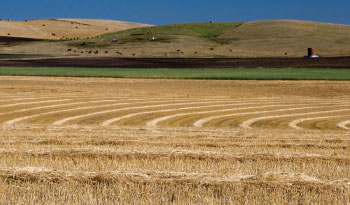Are biofuels fueling hunger?
by Joel Preston Smith
This article was originally published in September 2010

The U.S. Navy celebrated Earth Day this year by running a biofuels test on a supersonic F/A 18 Green Hornet fighter jet powered by a mixture of traditional jet fuel and oil pressed from Camelina sativa, a relative of the mustard plant.
The test underscores two trends in U.S. energy policy: an almost fanatical reliance on biofuels to substitute for oil, and the misconception that anything “green” is good — even if it sports Sidewinder missiles and makes the Hummer look fossil-fuel efficient.
Some experts on food security claim otherwise. Once touted as a panacea for America’s energy ills, biofuels now are charged with jacking up food prices, felling rainforests, boosting greenhouse gases, culling biodiversity, and deepening hunger in food-insecure nations.
The International Food Policy Research Institute argued before a 2008 U.S. Senate committee that biofuel production may have driven up grain prices as much as 30 percent from 2000-2007. Organizations such as Oxfam International and the United Nations (U.N.) claim prices are up 40 percent, pricing food-relief agencies out of the market and diminishing stocks of surplus food supplies.
By 2007, the relationship between biofuels and hunger had become so entrenched that Jean Ziegler, U.N. independent expert on the right to food, called for a five-year moratorium on biofuel production, hoping researchers will develop fuels from agricultural byproducts rather than food itself.
In many cases, increased emissions from land-use change are likely to offset or even exceed the greenhouse gas savings obtained by replacing fossil fuels with biofuels, and impacts on water, soil and biodiversity are also a concern.
— Food and Agriculture Organization, 2008.
The moratorium never was enacted. Instead, faith in the biofuel religion spread and lately has infected investors and ag speculators, who envision an economy that greens wallets, though not necessarily the environment.
Washington state hosted seven biodiesel production facilities in 2008, although none of the state’s corn, wheat or barley crops were used for ethanol production, according to the state department of agriculture.
A new Department of Defense contract with a Washington biofuel supplier, however, has renewed interest among some investors, after Sustainable Oils of Seattle won a $2.7 million contract from the U.S. Defense Energy Support Center to supply camelina oil for the Navy’s Earth Day biofuel demonstration and other military maneuvers.
“Green” fuel production is driven partly by the Energy Security and Independence Act of 2007, which mandated that 36 billion gallons of renewable fuels be pumped out of U.S. factories by 2022. It’s also driven by profit motive, of course, leading to fears that plants may be genetically engineered to raise their biofuel potential, further threatening food stability around the globe.
Biofuel investment is growing but won’t likely green Washington’s economy anytime soon, according to Jonathan Yoder, associate professor of economics at Washington State University in Pullman. Yoder argues that even with tax credits to spur biofuel development, such credits “almost certainly would cost the state more than the economic benefits that the tax credit would generate for state producers and consumers in the biofuel industry.”
Green is the new brown
According to the U.N.’s Food and Agriculture Organization (FAO), biofuel production is forcing the conversion of pastureland into crops, redefining global culture and ecology. Roughly 80 percent of global agricultural land was in pasture in 2008, says the FAO — 26 percent of the “ice-free terrestrial surface of the planet” — but biofuel cropland is increasing steadily. Consequently, nearly 1,500 livestock breeds are at risk of extinction, according to the agency’s Domestic Animal Diversity Information System.
Annie Shattuck, a policy analyst at the Institute for Food and Development Policy in Oakland, Calif., says biofuels are concentrating land ownership in developing nations and driving small farmers into landlessness and poverty.
She cites as examples the recent “acquisition” of 9,500 hectares of farmland by the Phnom Penh Sugar Company in Cambodia to grow feedstock for ethanol production. The Cambodian government awarded the land — previously held by 12 farmers — and “dumped the farmers like chickens into the slums,” Shattuck says.
In Australia, monoculture eucalyptus plantations, grown for cellulosic ethanol, have supplanted native forests. The Orangutan Conservancy argues that the palm oil industry now outranks poachers in Indonesia as the greatest threat to the orangutan’s survival.
The United Nations Environment Programme estimates that due in part to biofuels production, 98 percent of Indonesia’s rainforests will be razed by 2022 at the current rate of deforestation, and the orangutan likely will go with them.
“Biofuels absolutely are a threat to hunger,” Shattuck explains, “but it’s not as direct a relationship as many people have argued. What we’re seeing is a dramatic shift in land ownership, from investors buying up enormous tracts of land for biofuel production. We call them green deserts.”
